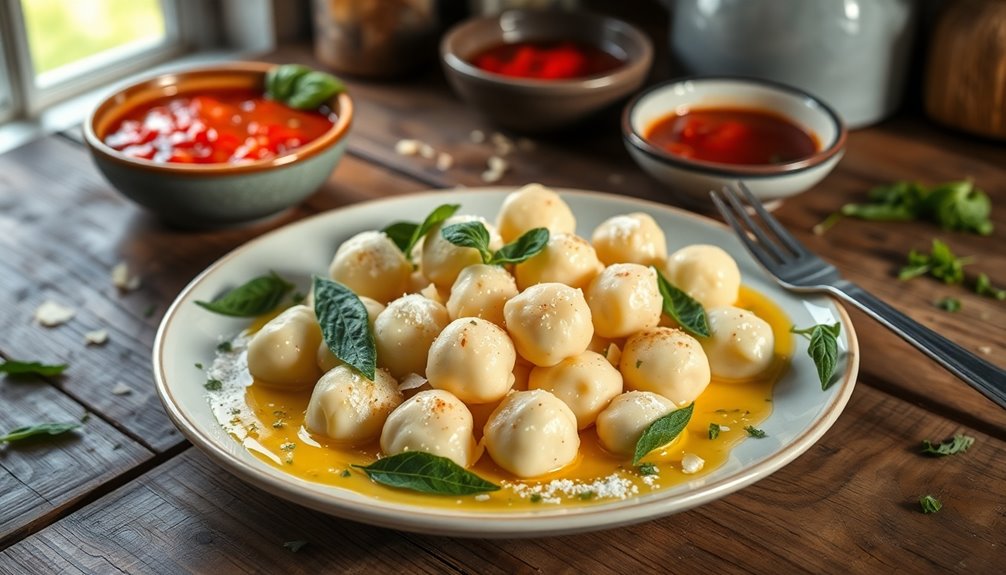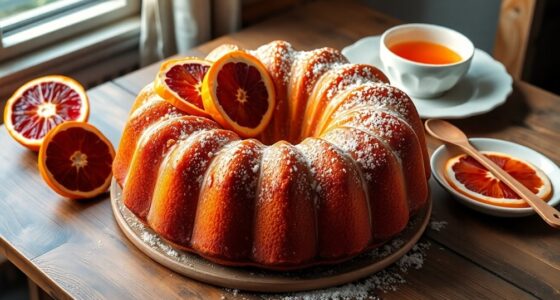Ricotta gnudi, which means "naked" in Italian, are light dumplings from Tuscany made primarily with ricotta cheese and minimal flour. They're crafted by mixing ricotta, Parmesan, egg, and flour into a soft dough, then rolling it into small balls. After chilling, they're boiled until they float, usually about 2-3 minutes. Serve them with a rich brown butter and sage sauce or a light marinara for an authentic flavor. Discover why these dumplings are a beloved Tuscan tradition.
History
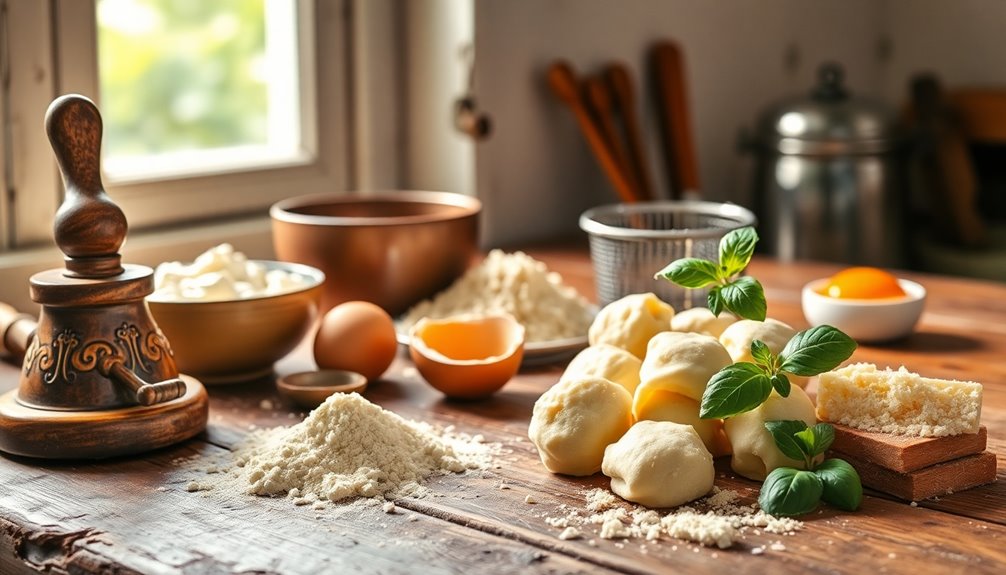
Gnudi, which translates to "naked" in Italian, has its roots in Tuscany, where it emerged as a clever way to use up leftover ricotta and other ingredients. This dish reflects the frugal meal philosophy of rural families, turning what might be waste into a delightful culinary experience.
Traditionally, gnudi were made with ricotta and spinach, showcasing local produce and the region's agricultural practices. The lighter, fluffier texture sets gnudi apart from gnocchi, thanks to the emphasis on cheese over flour.
While gnocchi has its variations across Italy, gnudi remains a cherished part of Tuscan cuisine, celebrated for its simplicity and adherence to Italian culinary traditions. This dish truly embodies the resourcefulness of the region's cooking. Additionally, its preparation often involves using local produce, reinforcing the connection between the dish and the agricultural heritage of Tuscany.
Recipe
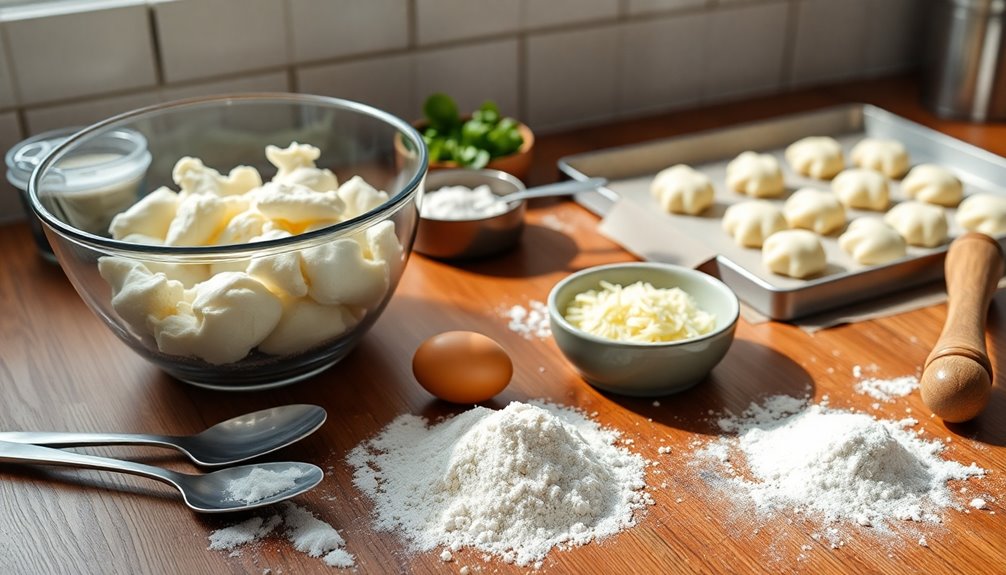
Ingredients:
- 12 ounces drained ricotta cheese
- 2 ounces grated Parmesan cheese
- 1 egg
- 1/2 cup all-purpose flour
- 1/4 cup semolina flour
- Salt, to taste
- Fresh herbs (for garnish)
- Additional cheese (for serving)
- Butter and sage (for sauce, optional)
Cooking Instructions:
In a mixing bowl, combine the drained ricotta, grated Parmesan, and egg until well blended.
Gradually add both the all-purpose and semolina flour, mixing until a soft dough forms. Be careful not to overwork the dough, as this can make the gnudi dense.
Once the dough is formed, generously dust your work surface with flour and divide the dough into small portions.
Roll each portion into small balls, about the size of a walnut, and place them on a floured baking sheet.
Chill the gnudi in the refrigerator for at least 30 minutes to an hour to help them hold their shape during cooking.
To cook, bring a pot of salted water to a gentle boil and carefully drop the gnudi in, cooking them until they float to the surface, typically around 2 to 3 minutes.
Extra Tips:
For the best results, use high-quality ricotta that's well-drained to prevent excess moisture in the dough.
If your dough feels too sticky, you can add a little more flour, but be cautious not to make it too dry.
When serving, consider pairing the gnudi with a simple browned butter and sage sauce for a rich flavor or a light marinara for a fresh touch.
Garnishing with additional grated cheese and fresh herbs will elevate the dish beautifully.
Enjoy your homemade ricotta gnudi!
Cooking Steps
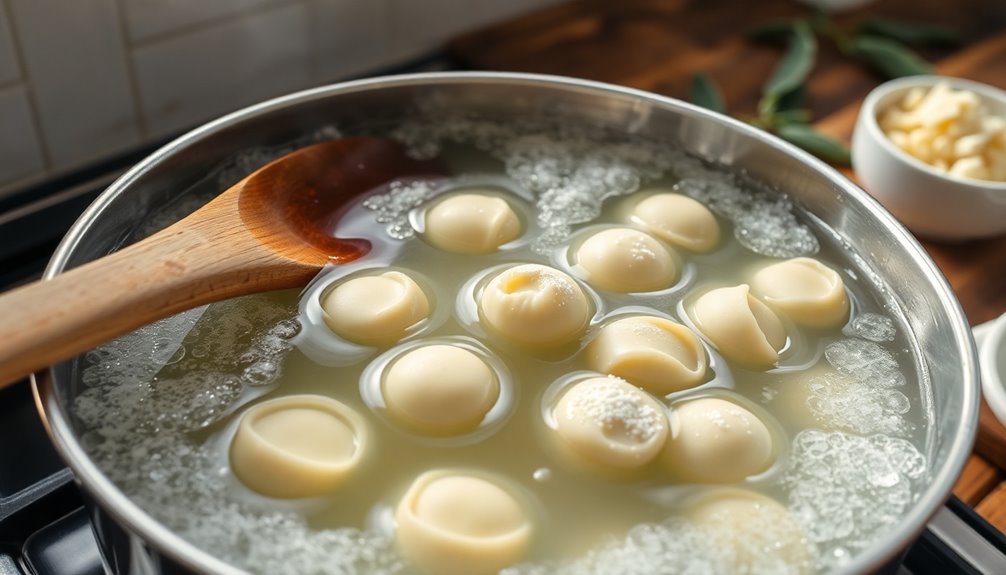
To start making your ricotta gnudi, choose creamy, fresh ricotta and mix it with salt and pepper for flavor.
Once you've got the mixture ready, chill it on parchment paper before scooping it with a spoon and forming small balls.
This step is essential for achieving that perfect texture in your gnudi.
Step 1. Choose Creamy, Fresh Ricotta
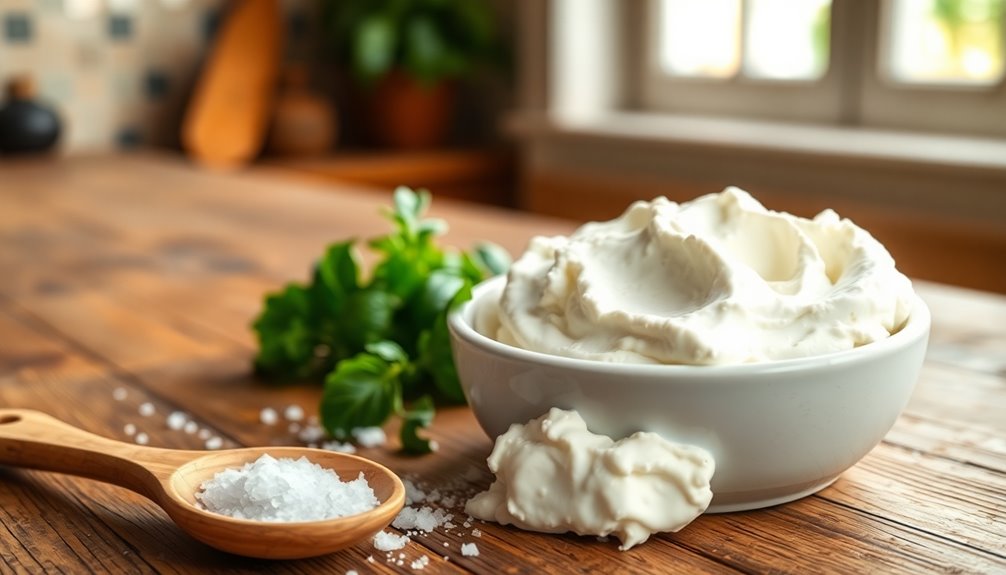
How do you guarantee your ricotta gnudi turn out perfectly creamy and flavorful? Start with high-quality, fresh ricotta that contains just milk, salt, and possibly an acid. Avoid those lower-quality options filled with gums and stabilizers.
For the best flavor, opt for freshly made sheep's milk ricotta, which adds a delightful grassiness and acidity.
After selecting your ricotta, drain it using a fine mesh sieve or by pressing it on paper towels to remove excess moisture. Aim for 12 ounces of drained ricotta to secure the right consistency when mixing with other ingredients like Parmesan cheese. Additionally, using HEPA filtration in your kitchen can help improve air quality by removing allergens, ensuring a healthier cooking environment.
Step 2. Add Salt and Pepper
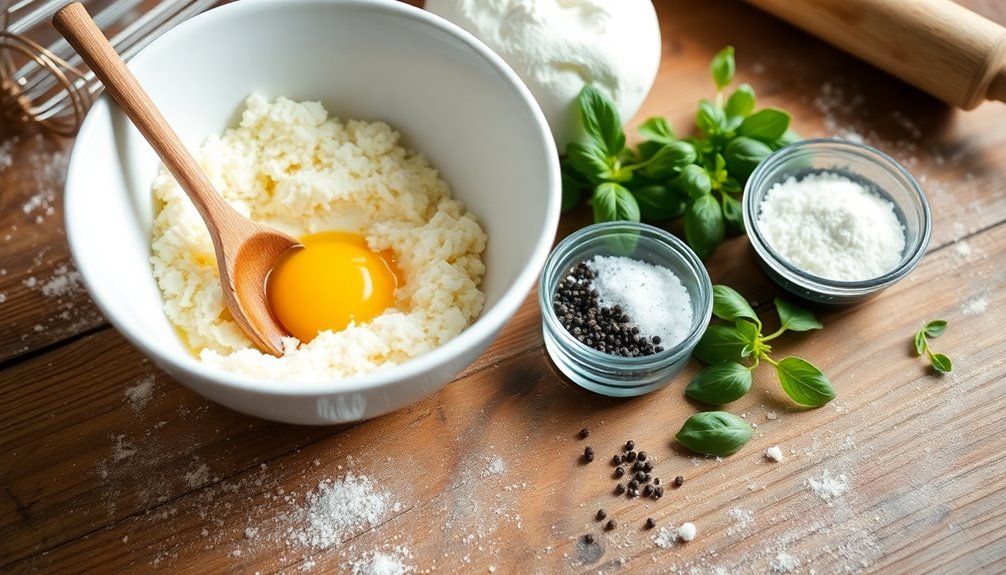
Elevate the flavor of your ricotta gnudi by adding salt and pepper to the mixture.
Start by incorporating 1.5 teaspoons of kosher salt; this will enhance flavor and balance the richness of the cheese. Next, add 0.5 teaspoons of freshly cracked black pepper to the ricotta mixture, giving it a delightful depth and a subtle kick.
Use a rubber spatula to mix thoroughly, ensuring these seasonings are evenly distributed. Remember to adjust the salt and pepper to your taste, as the cheese contributes some inherent saltiness.
For an extra layer of flavor, consider adding a pinch of nutmeg or some fresh herbs alongside the salt and pepper in the ricotta mixture.
Enjoy crafting your perfect gnudi!
Step 3. Chill Mixture on Parchment Paper
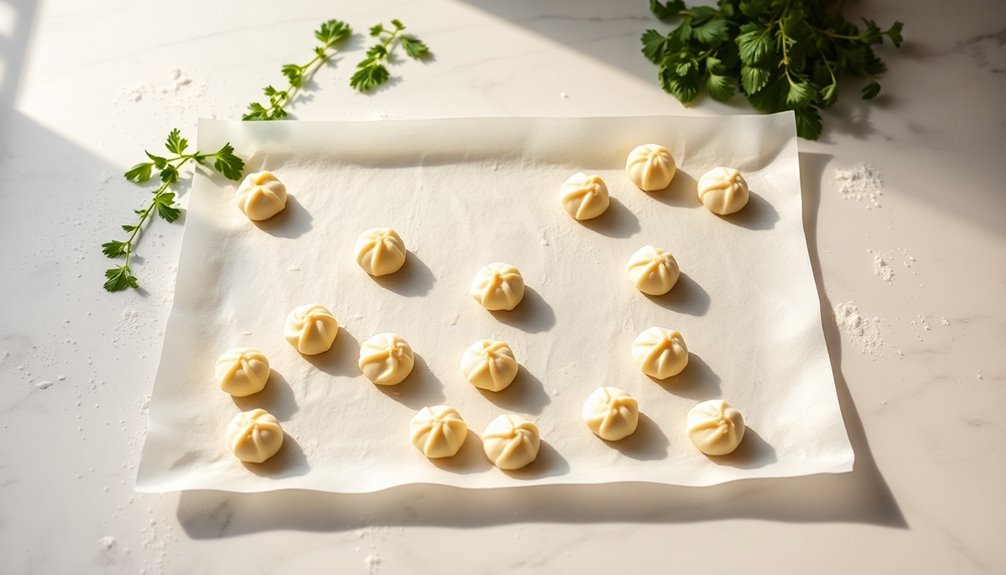
After mixing your ricotta gnudi ingredients, spread the mixture onto a sheet of parchment paper in a thin layer. This helps the mixture chill evenly.
Place the parchment paper in the freezer for about 15 minutes, allowing the mixture to firm up. This step is essential as it helps maintain the shape during scooping.
Once chilled, return the mixture to a bowl and break up any frozen chunks with a spatula for a consistent texture.
Use a small cookie scoop to portion out the mixture, ensuring you get uniform sizes.
Finally, roll the gnudi in semolina flour for an even coating, which will help prevent sticking during cooking.
Enjoy your delicious ricotta gnudi!
Step 4. Scoop With a Spoon
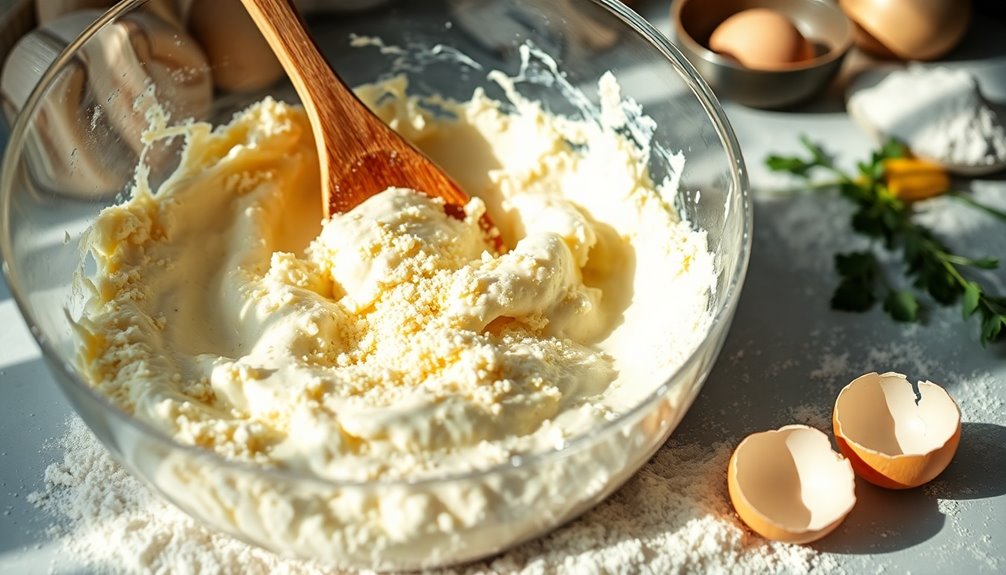
To create perfectly shaped ricotta gnudi, start by using a small cookie scoop to portion the chilled mixture. This guarantees each ball is uniform in size, which is key for even cooking in boiling water.
After scooping, gently coat the ricotta balls in semolina flour, helping them maintain their shape and adding a delightful texture. Aim for a consistent size, about a tablespoon or slightly larger, to avoid any uneven cooking.
Handle the scooped mixture carefully; compressing it can lead to a denser gnudi instead of the light, airy texture you want. Place the scooped gnudi on a floured baking sheet and chill in the refrigerator for at least 30 minutes before boiling to help them firm up.
Step 5. Form Into Small Balls
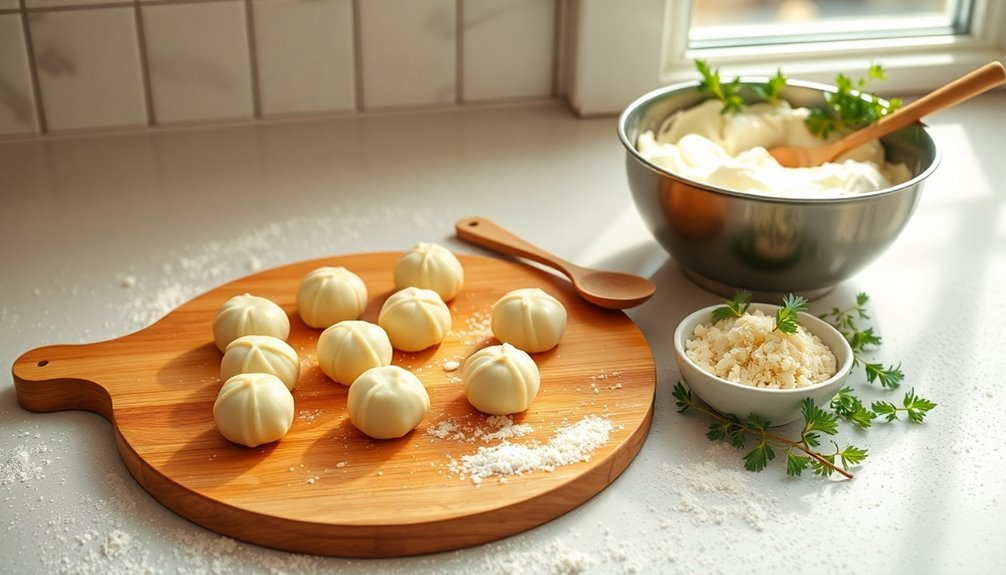
Start by scooping out 12 ounces of drained ricotta mixed with 2 ounces of grated Parmesan cheese using a small cookie scoop.
Next, roll the scooped ricotta mixture into small balls, ensuring they're gently shaped into uniform spheres with your fingertips.
Once formed, coat each gnudi evenly with semolina flour to prevent sticking and help maintain their shape during boiling.
After coating, chill the gnudi in the refrigerator for at least 20 minutes; this step is essential for firming them up, reducing the risk of falling apart in the water.
Finally, dust a baking sheet and the tops of the gnudi with additional semolina flour to keep these delicate dumplings from sticking together.
Enjoy your delicious ricotta gnudi!
Final Thoughts
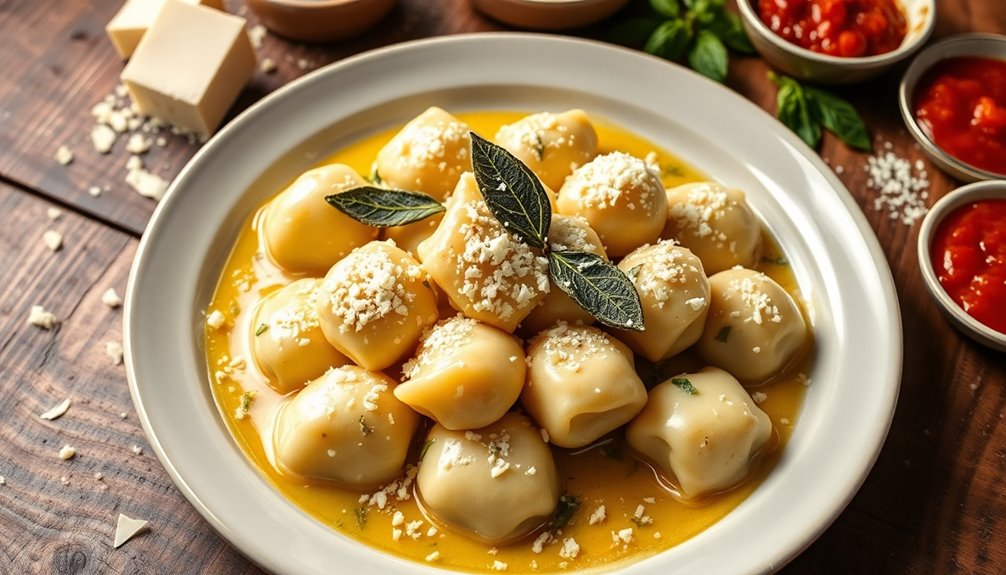
While you might be tempted to stick with traditional pasta, ricotta gnudi offers a delightful and lighter alternative that's worth exploring. The key to perfecting these "naked" dumplings lies in using high-quality ricotta and minimal flour, resulting in a light texture.
Pair your gnudi with a luscious brown butter and sage sauce, or try marinara for something different. Don't forget the importance of resting time; allowing the mixture to chill for at least 18 hours helps firm it up, ensuring they hold their shape while cooking.
If you find yourself with leftovers, store cooked gnudi in an airtight container for up to three days, or refrigerate uncooked gnudi for 24-48 hours. Enjoy this exquisite dish!
Frequently Asked Questions
What Is the Difference Between Gnudi and Ricotta Gnocchi?
Gnudi and ricotta gnocchi differ primarily in texture and ingredients.
When you make gnudi, you focus on a light, delicate dumpling with minimal flour, showcasing the creaminess of the cheese.
In contrast, ricotta gnocchi has a denser structure due to the significant amount of flour added.
While gnudi is often paired with simple sauces like brown butter, ricotta gnocchi can complement a variety of sauces, making them distinct in preparation and presentation.
What Does Gnudi Mean?
Gnudi means "naked," and it's like the pasta world's best-kept secret!
This term refers to a type of pasta that contains delicious fillings without the outer shell. You'll find it typically made with cheese, giving it a light and fluffy texture that's simply irresistible.
Originating from Tuscany, gnudi offers a delightful twist on traditional pasta, allowing you to savor flavors in their purest form.
Just think of it as pasta's charmingly naked cousin!
How Do You Pronounce Ricotta Gnudi?
To pronounce "Ricotta Gnudi," you'll want to focus on the syllables.
Start with "Ricotta," saying it as "ree-KOH-tah," emphasizing the second syllable.
Next, tackle "Gnudi," which is pronounced as "NYOO-dee," with the emphasis on the first syllable. The "gn" creates a unique sound similar to "ny" in "canyon."
When you put it all together, you get "ree-KOH-tah NYOO-dee," flowing smoothly for an authentic Italian flair.
Is Ricotta Gnocchi Healthy?
Isn't it fascinating how what we eat can shape our health?
When you consider ricotta gnocchi, it can be a healthy choice, especially if it's made with quality ingredients. Its base, ricotta cheese, provides protein and calcium, which are essential for your body.
If you're mindful about portion sizes and pair it with vegetables, you can enjoy a nutritious meal.
Just remember, moderation is key to a balanced diet!
